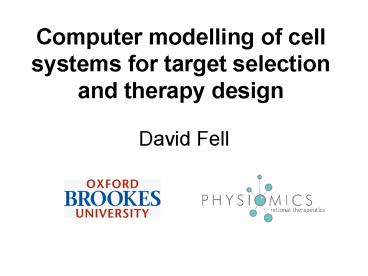Computer modelling of cell systems for target selection and therapy design - PowerPoint PPT Presentation
1 / 31
Title:
Computer modelling of cell systems for target selection and therapy design
Description:
Metabolic control analysis shows the need for a system-based perspective. ... Inhibition of GAR Transformylase in. Human Leukaemia T-cells ... – PowerPoint PPT presentation
Number of Views:48
Avg rating:3.0/5.0
Title: Computer modelling of cell systems for target selection and therapy design
1
Computer modelling of cell systems for target
selection and therapy design
- David Fell
2
Outline
- Metabolic control analysis shows the need for a
system-based perspective. - Computer simulation of a signal transduction
system and the effect of a drug candidate. - Perspective on future developments.
3
Metabolic control analysis
Salter et al (1986) Biochem. J. 234, 635-647.
4
(No Transcript)
5
(No Transcript)
6
(No Transcript)
7
(No Transcript)
8
Inhibitor titrations of enzymes
Titration of complex IV of rat kidney
mitochondrial respiration.
From Rossignol et al, (1999) J Biol Chem, 274,
3342633432.
9
Inhibitor titrations of enzymes
10
Inhibition of mitochondrial complex IV control
CrespIV slope a/slope b 0.2
From Rossignol et al, (2000) Biochem J, 347,
45-53.
11
Inhibition of mitochondrial complex IV IC50
a IC50 for enzyme b IC50 for respiration
From Rossignol et al, (2000) Biochem J, 347,
45-53.
12
Control coefficients matter for drug response!
CrespI 0.26
CrespIII 0.02
13
Inhibition type and potency at the system level
- Tight-binding non-competitive or irreversible
inhibitors (illustrated) are a favourable case. - Competitive inhibition shows more divergent
behaviour between system and enzyme system
opposes change - weaker response. - With uncompetitive and mixed inhibition, the
system response potentiates the inhibition. - See Eisenthal, R. Cornish-Bowden, A. (1998) J.
Biol. Chem. 273, 5500-5505.
14
Case study Target SelectionInhibition of GAR
Transformylase in Human Leukaemia T-cells
Control coefficient 0.01 poor target,
stringent demands on chemistry, weak clinical
effect
15
Case Study ClinicalThiamine (Vit B1)
Supplements
- Clinical practice
- Advanced cancer patients are thiamine deficient
(deficit of 40) so nutritional supplements are
given to extend life expectancy
- Control Analysis
- Transketolase has a control coefficient on
growth of 0.9 in thiamine-depleted cells, so
added thiamine drives nucleic acid synthesis and
cancer growth. Restoring normal thiamine levels
increases cancer growth up to 164. However,
transketolase is a potential target.
Begona, C-A et al. Eur. J. Biochem 268 (2001)
4177-4182.
16
Signal transduction networks
- The degrees of sensitivity of signalling outputs
to properties of the system components are also
variable - illustrated with a computer model of the EGF
signal transduction from receptor to the MAPK
cascade. - Brightman Fell (2000), FEBS Lett. 482, 169-174.
17
Receptor binding module of EGF model
18
Intermediate module
19
MAPK module of EGF model
GS Grb2-SOS-Shc complex
20
Sensitivity of peak Ras to some model parameters
4.50
4.00
3.50
3.00
2.50
Log peak Ras activation
2.00
1.50
1.00
0.50
0.00
-6.00
-5.00
-4.00
-3.00
-2.00
-1.00
0.00
1.00
2.00
3.00
-0.50
Log parameter value
21
Sensitivity of maximum ERK phosphorylation is
variable
22
Peak Shc, Ras and ERK phosphorylation
23
EGF Inhibition
EGF
ras
c-raf1
EGFR
MEK
ERK
Nucleus
Phosphate group
Inhibited by Iressa (ZD1839)
Inhibited by ZM 336372
24
Paradoxical activation of Raf
- Zeneca developed ZM 336372 as an inhibitor of
Raf. - Although if inhibits phosphorylation of MAPK
cascade components by Raf, it results in higher
levels of Raf in treated cells. - This Raf activation was termed paradoxical by
Hall-Jackson et al (Chem Biol. 6, 559-568,
1999). - The following simulations of PC12 cells are for
drug at 5x its IC50.
25
Simulation of ZM336372 ERK
26
Simulation of ZM336372 Raf
27
The future in silico tissue
Cell Mass in clinical environment
28
Cell cycle simulation
(Based on Tyson Novak, JTB 210, 249-263, 2001.)
29
SystemCell simulation
30
Overall conclusions for drug development
- Modelling of many cellular systems relevant to
diseases is within reach. - Models could be used to inform target selection
and to design therapies - Barriers include
- poor acceptability by experimental biologists
- old data is buried in paper-based literature
- much modern data is either qualitative or
relative absolute quantitation is out of fashion
31
Acknowledgements
- Oxford Brookes University
- Frances Brightman
- Université Bordeaux 2
- Christophe Chassagnole
- Jean-Pierre Mazat
- Thierry Letellier
- Physiomics plc
- John Savin
- Nazia Hussain































